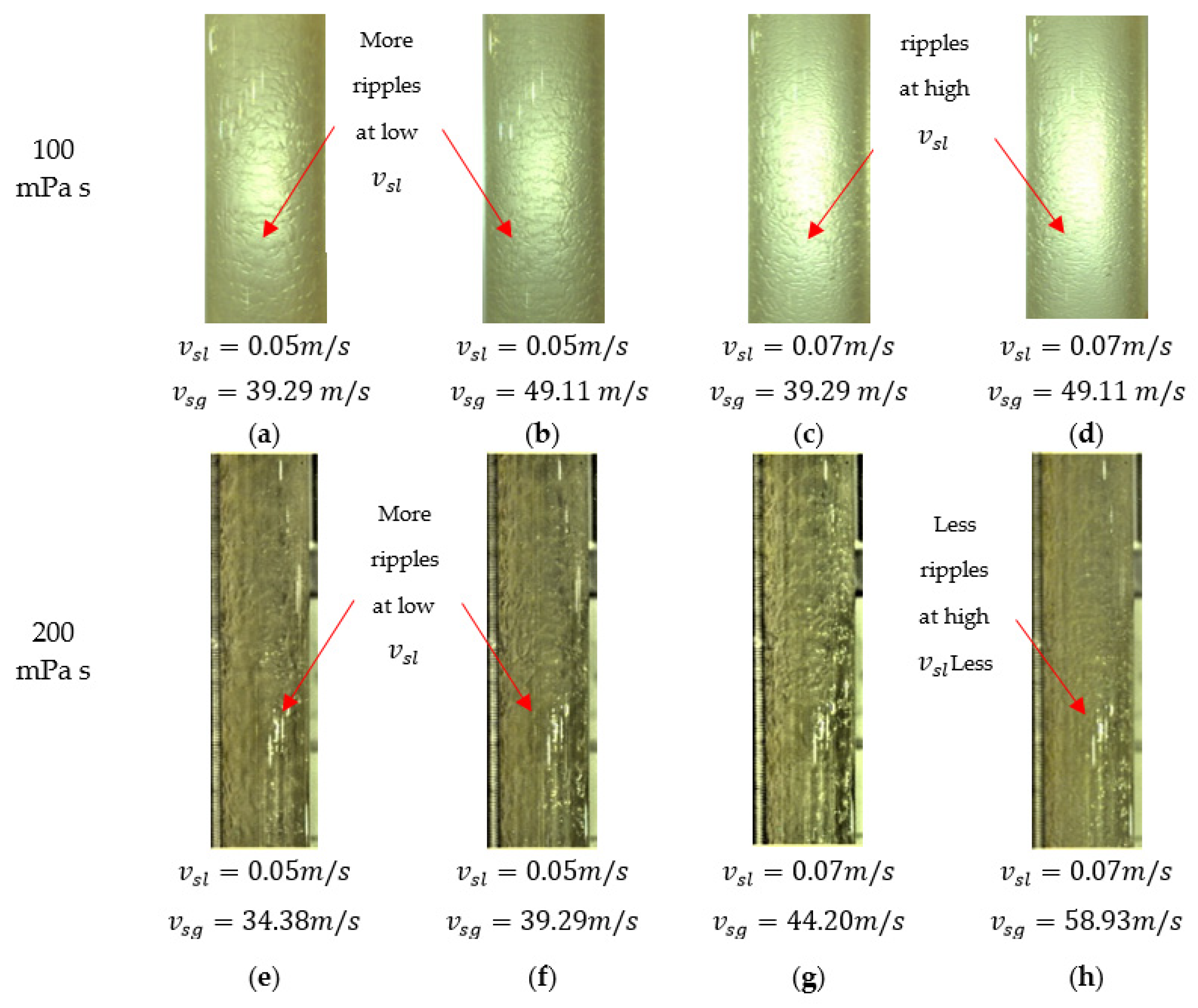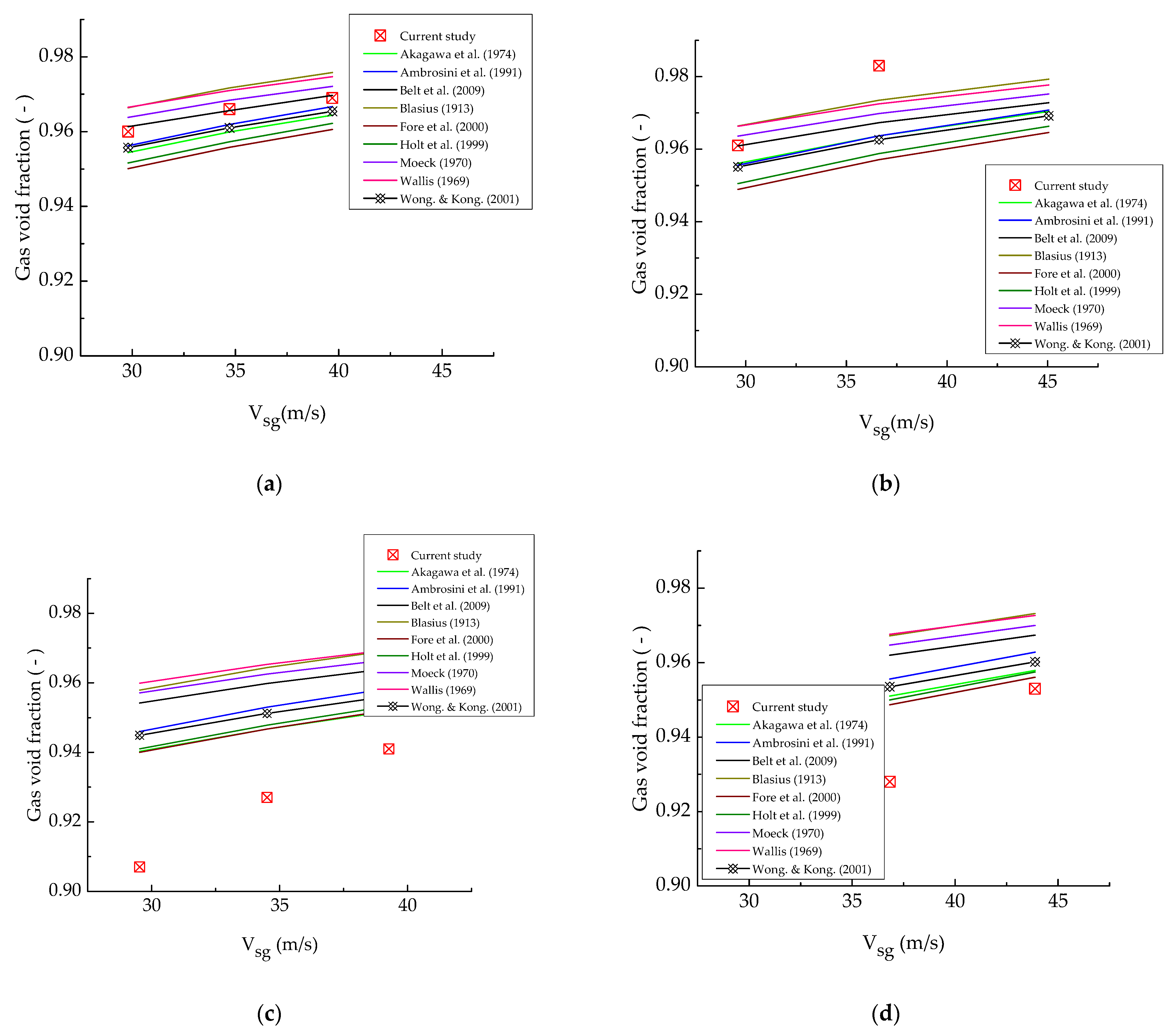A Two-Fluid Model for High-Viscosity Upward Annular Flow in Vertical Pipes
Abstract
:1. Introduction
1.1. Previous Works
1.2. The Two-Fluid Model
1.3. Closure Relationships
1.4. Test Rig Description
1.5. Fluid Properties for the Experiment
2. Experimental Procedure and Measurements
3. Results
3.1. Experimental Results and Discussion
3.1.1. Visual Observations and Identification of Flow Regime
3.1.2. Visual Observations and Flow Regime Identification
3.2. Liquid Holdup
3.3. Pressure Drop
3.4. Liquid Film Thickness
3.5. Influence of Various Interfacial Frication Factors on Predictions of Liquid Film Thickness, Gas Void Fraction and Pressure Gradient
3.5.1. Liquid Film Thickness
3.5.2. Gas Void Fraction
3.5.3. Pressure Gradient
4. Conclusions
Author Contributions
Funding
Institutional Review Board Statement
Informed Consent Statement
Data Availability Statement
Conflicts of Interest
Abbreviations
| area | |
| [m] | diameter |
| [-] | Froude number |
| [-] | friction factor |
| [-] | droplet entrainment fraction |
| g [m/s2] | gravitational acceleration |
| H [-] | Holdup |
| [-] | Reynolds number |
| [m] | perimeter |
| t [m] | liquid film thickness |
| v [m/s] | velocity |
| [Pa/m] | pressure gradient |
| Greek letters | |
| [] | shear stress |
| [m] | liquid film thickness |
| [] | density |
| [] | angle of inclination |
| [-] | gas void fraction |
| [mPa s] | viscosity |
| surface tension | |
| Subscripts | |
| C | Core |
| F | Film |
| wall-liquid interface | |
| interfacial | |
| liquid | |
| superficial liquid | |
| superficial gas | |
References
- Al-Ruhaimani, F.; Pereyra, E.; Sarica, C.; Al-Safran, E.M.; Torres, C.F. Experimental Analysis and Model Evaluation of High-Liquid-Viscosity Two-Phase Upward Vertical Pipe Flow. SPE J. 2017, 22, 712–735. [Google Scholar] [CrossRef]
- Alamu, M.B. Investigation of Periodic Structures in Gas-Liquid Flow. Ph.D. Thesis, University of Nottingham, Nottingham, UK, 2010. [Google Scholar]
- Hamad, F.A.; Faraji, F.; Santim, C.G.S.; Basha, N.; Ali, Z. Investigation of pressure drop in horizontal pipes with different diameters. Int. J. Multiph. Flow 2017, 91, 120–129. [Google Scholar] [CrossRef] [Green Version]
- Ribeiro, J.X.F.; Liao, R.; Aliyu, A.M.; Liu, Z. Upward interfacial friction factor in gas and high-viscosity liquid flows in vertical pipes. Chem. Eng. Commun. 2019, 1–30. [Google Scholar] [CrossRef]
- Funahashi, H.; Kirkland, V.K.; Hayashi, K.; Hosokawa, S.; Tomiyama, A. Interfacial and wall friction factors of swirling annular flow in a vertical pipe. Nucl. Eng. Des. 2018, 330, 97–105. [Google Scholar] [CrossRef]
- Bbosa, B.; DelleCase, E.; Volk, M.; Ozbayoglu, E. A comprehensive deposition velocity model for slurry transport in horizontal pipelines. J. Pet. Explor. Prod. Technol. 2017, 7, 303–310. [Google Scholar] [CrossRef] [Green Version]
- Alves, I.M.; Caetano, E.F.; Minami, K.; Shoham, O. Modeling Annular Flow Behavior for Gas Wells. SPE Prod. Eng. 1991, 6, 435–440. [Google Scholar] [CrossRef]
- Oliemans, R.V.A.; Pots, B.F.M.; Trompé, N. Modelling of annular dispersed two-phase flow in vertical pipes. Int. J. Multiph. Flow 1986, 12, 711–732. [Google Scholar] [CrossRef]
- Vieira, R.E.; Parsi, M.; McLaury, B.S.; Shirazi, S.A.; Torres, C.F.; Schleicher, E.; Hampel, U. Experimental characterization of vertical gas–liquid pipe flow for annular and liquid loading conditions using dual Wire-Mesh Sensor. Exp. Therm. Fluid Sci. 2015, 64, 81–93. [Google Scholar] [CrossRef]
- Zhang, H.-Q.; Wang, Q.; Sarica, C.; Brill, J.P. Unified Model for Gas-Liquid Pipe Flow via Slug Dynamics—Part 1: Model Development. J. Energy Resour. Technol. 2003, 125, 266–273. [Google Scholar] [CrossRef]
- Bendiksen, K.H.; Maines, D.; Moe, R.; Nuland, S. The Dynamic Two-Fluid Model OLGA: Theory and Application. SPE Prod. Eng. 1991, 6, 171–180. [Google Scholar] [CrossRef]
- Aziz, K.; Govier, G.W. Pressure Drop In Wells Producing Oil And Gas. J. Can. Pet. Technol. 1972, 11, 38–48. [Google Scholar] [CrossRef]
- Hagedorn, A.; Brown, K. The Effect of Liquid Viscosity in Two-Phase Vertical Flow. J. Pet. Technol. 1964, 16, 203–210. [Google Scholar] [CrossRef]
- Duns, H.; Ros, N.C.J. Vertical flow of gas and liquid mixtures in wells. In Proceedings of the 6th World Petroleum Congress, Frankfurt am Main, Germany, 19–26 June 1963; pp. 451–465. [Google Scholar]
- Mukherjee, H.; Brill, J.P. Pressure Drop Correlations for Inclined Two-Phase Flow. J. Energy Resour. Technol. 1985, 107, 549–554. [Google Scholar] [CrossRef]
- Beggs, D.H.; Brill, J.P. A Study of Two-Phase Flow in Inclined Pipes. J. Pet. Technol. 1973, 25, 607–617. [Google Scholar] [CrossRef]
- Orkiszewski, J. Predicting Two-Phase Pressure Drops in Vertical Pipe. J. Pet. Technol. 1967, 19, 829–838. [Google Scholar] [CrossRef]
- Fontalvo, E.M.G.; Branco, R.L.C.; Carneiro, J.N.E.; Nieckele, A.O. Assessment of closure relations on the numerical predictions of vertical annular flows with the two-fluid model. Int. J. Multiph. Flow 2020, 126. [Google Scholar] [CrossRef]
- Sanderse, B.; Buist, J.F.H.; Henkes, R.A.W.M. A novel pressure-free two-fluid model for one-dimensional incompressible multiphase flow. J. Comput. Phys. 2021, 426, 109919. [Google Scholar] [CrossRef]
- Liu, Z.; Su, Y.; Lu, M.; Zheng, Z.; Liao, R. Frictional Pressure Drop and Liquid Holdup of Churn Flow in Vertical Pipes with Different Viscosities. Geofluids 2021. [Google Scholar] [CrossRef]
- Imam, M.M.; Basha, M.; Shaahid, S.M.; Ahmad, A.; Al-Hadhrami, L.M. Effect of viscosity on the pressure gradient in 4-inch pipe. ASME Int. Mech. Eng. Congr. Exp. Proc. 2014, 7. [Google Scholar] [CrossRef]
- Ganat, T.; Ridha, S.; Hairir, M.; Arisa, J.; Gholami, R. Experimental investigation of high-viscosity oil–water flow in vertical pipes: Flow patterns and pressure gradient. J. Pet. Explor. Prod. Technol. 2019, 9, 2911–2918. [Google Scholar] [CrossRef] [Green Version]
- McNeil, D.A.; Stuart, A.D. The effects of a highly viscous liquid phase on vertically upward two-phase flow in a pipe. Int. J. Multiph. Flow 2003, 29, 1523–1549. [Google Scholar] [CrossRef]
- Wongwises, S.; Kongkiatwanitch, W. Interfacial friction factor in vertical upward gas-liquid annular two-phase flow. Int. Commun. Heat Mass Transf. 2001, 28, 323–336. [Google Scholar] [CrossRef]
- Aliyu, A.M.; Baba, Y.D.; Lao, L.; Yeung, H.; Kim, K.C. Interfacial friction in upward annular gas–liquid two-phase flow in pipes. Exp. Therm. Fluid Sci. 2017, 84, 90–109. [Google Scholar] [CrossRef]
- Wallis, G.B. One-Dimensional Two-phase Flow; McGraw Hill: New York, NY, USA, 1969. [Google Scholar]
- Sawant, P.; Ishii, M.; Mori, M. Prediction of amount of entrained droplets in vertical annular two-phase flow. Int. J. Heat Fluid Flow 2009, 30, 715–728. [Google Scholar] [CrossRef]
- Aliyu, A.M.; Almabrok, A.A.; Baba, Y.D. Prediction of entrained droplet fraction in co-current annular gas–liquid flow in vertical pipes. Exp. Therm. Fluid Sci. 2017, 85, 287–304. [Google Scholar] [CrossRef] [Green Version]
- Zhang, H.-Q.; Wang, Q.; Sarica, C.; Brill, J.P. Unified Model for Gas-Liquid Pipe Flow via Slug Dynamics—Part 2: Model Validation. J. Energy Resour. Technol. 2003, 125, 274. [Google Scholar] [CrossRef]
- Ambrosini, W.; Andreussi, P.; Azzopardi, B.J. A physically based correlation for drop size in annular flow. Int. J. Multiph. Flow 1991, 17, 497–507. [Google Scholar] [CrossRef]
- Matsuyama, F.; Sadatomi, M.; Nakashima, K.; Johno, Y.; Shigematsu, T. Effects of surface tension on liquid film behavior and interfacial shear stress in upward annular flows in a vertical pipe. J. Mech. Eng. Autom. 2013, 7, 1–8. [Google Scholar] [CrossRef]
- Belt, R.J.; Van’t Westende, J.M.C.; Portela, L.M. Prediction of the interfacial shear-stress in vertical annular flow. Int. J. Multiph. Flow 2009, 35, 689–697. [Google Scholar] [CrossRef]
- Fore, L.B.; Beus, S.G.; Bauer, R.C. Interfacial friction in gas-liquid annular flow: Analogies to full and transition roughness. Int. J. Multiph. Flow 2000, 26, 1755–1769. [Google Scholar] [CrossRef] [Green Version]
- Holt, A.J.; Azzopardi, B.J.; Biddulph, M.W. Calculation of two-phase pressure drop for vertical upflow in narrow passages by means of a flow pattern specific model. Chem. Eng. Res. Des. 1999, 1, 7–15. [Google Scholar] [CrossRef]
- Moeck, E.O. Annular-Dispersed Two-Phase Flow and Critical Heat Flux. 1970. Available online: https://astee-tsm.fr/10.1051/tsm/201201037 (accessed on 1 June 2021).
- Fukano, T.; Furukawa, T. Prediction of the Effect of Liquid Viscosity on Interfacial Shear Stress and Frictional Pressure Drop in Vertical Upward Gas Liquid Annular Flow. Int. J. Multiph. Flow 1998, 24, 587–603. [Google Scholar] [CrossRef]
- Asali, J.C.; Hanratty, T.J.; Andreussi, P. Interfacial drag and film height for vertical annular flow. AIChE J. 1985, 31, 895–902. [Google Scholar] [CrossRef]
- Zangana, M.H.S. Film Behaviour of Vertical Gas-Liquid Flow in a Large Diameter Pipe. Ph.D. Thesis, University of Nottingham, Nottingham, UK, 2011. [Google Scholar]
- Van der Meulen, G.P. Churn-Annular Gas-Liquid Flows in Large Diameter Vertical Pipes. Ph.D. Thesis, University of Nottingham, Nottingham, UK, 2012. [Google Scholar]
- Shearer, C.J.; Nedderman, R.M. Pressure gradient and liquid film thickness in co-current upwards flow of gas/liquid mixtures: Application to film-cooler design. Chem. Eng. Sci. 1965, 20, 671–683. [Google Scholar] [CrossRef]
- Pinto del Corral, N. Analysis of Two-Phase Flow Pattern Maps. 2014. Available online: http://www.energetickeforum.cz/ext/2pf/maps/Documents/Analysis_of_maps.pdf (accessed on 1 June 2021).
- Taitel, Y.; Bornea, D.; Dukler, A.E. Modelling flow pattern transitions for steady upward gas-liquid flow in vertical tubes. AIChE J. 1980, 26, 345–354. [Google Scholar] [CrossRef]
- Kaji, R.; Azzopardi, B.J. The effect of pipe diameter on the structure of gas/liquid flow in vertical pipes. Int. J. Multiph. Flow 2010, 36, 303–313. [Google Scholar] [CrossRef]










| Parameter Measured | Equipment | Measuring Range | Accuracy |
|---|---|---|---|
| Gas Flow Rate | Endress+Hauser/65F1H Coriolis flowmeter | 160–2000 m3/h | ±0.1% |
| Liquid Flow Rate | Endress+Hauser/80E50 Coriolis flowmeter | 2–20 m3/h | ±0.3% |
| Pressure | Rosemount 305 1S Pressure transducers | 0–3.5 MPa | ±0.1% |
| Liquid Holdup | Limit Switch Box APL-210 | N/A |
| Fluid | Properties | ||
|---|---|---|---|
| Density (kg/m3) | Viscosity (mPa s) | Surface Tension | |
| Gas (Air) | 1.205 | 0.0181 (20 °C) | |
| Liquid (Oil) | 854 (20 °C) | 100–300 | 0.0287 (20 °C) |
| Measured Parameters | Range |
|---|---|
| System Pressure (MPa) (gauge pressure) | 0.04–0.14 |
| Temperature (℃) | 20.99–47.80 |
| Superficial gas velocity (m/s) | 22.37–59.06 |
| Superficial liquid velocity (m/s) | 0.05–0.16 |
| Pressure Drop (kPa) | 4.62–20.02 |
| Liquid Holdup (-) | 0.003–0.269 |
Publisher’s Note: MDPI stays neutral with regard to jurisdictional claims in published maps and institutional affiliations. |
© 2021 by the authors. Licensee MDPI, Basel, Switzerland. This article is an open access article distributed under the terms and conditions of the Creative Commons Attribution (CC BY) license (https://creativecommons.org/licenses/by/4.0/).
Share and Cite
Ribeiro, J.X.F.; Liao, R.; Aliyu, A.M.; Ahmed, S.K.B.; Baba, Y.D.; Almabrok, A.A.; Archibong-Eso, A.; Liu, Z. A Two-Fluid Model for High-Viscosity Upward Annular Flow in Vertical Pipes. Energies 2021, 14, 3485. https://doi.org/10.3390/en14123485
Ribeiro JXF, Liao R, Aliyu AM, Ahmed SKB, Baba YD, Almabrok AA, Archibong-Eso A, Liu Z. A Two-Fluid Model for High-Viscosity Upward Annular Flow in Vertical Pipes. Energies. 2021; 14(12):3485. https://doi.org/10.3390/en14123485
Chicago/Turabian StyleRibeiro, Joseph X. F., Ruiquan Liao, Aliyu M. Aliyu, Salem K. B. Ahmed, Yahaya D. Baba, Almabrok A. Almabrok, Archibong Archibong-Eso, and Zilong Liu. 2021. "A Two-Fluid Model for High-Viscosity Upward Annular Flow in Vertical Pipes" Energies 14, no. 12: 3485. https://doi.org/10.3390/en14123485








